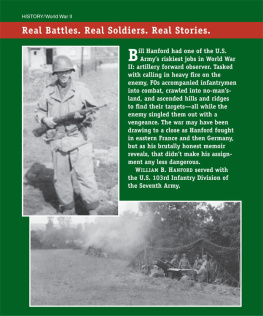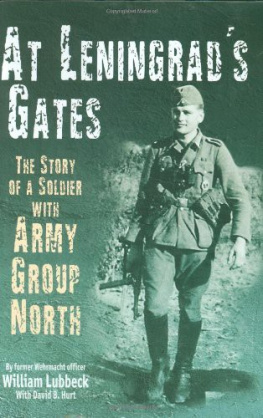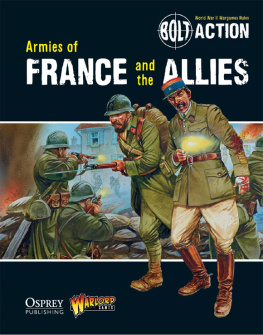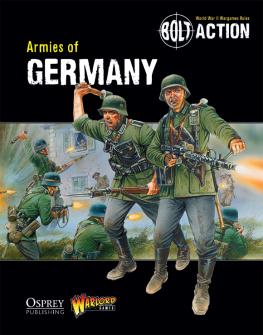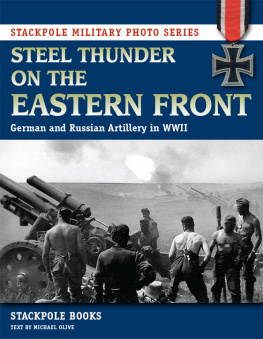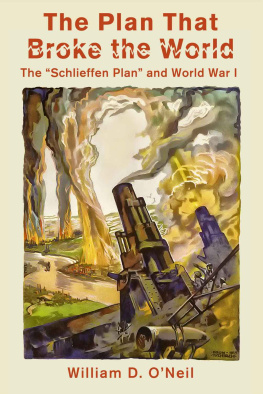The Stackpole Military History Series
THE AMERICAN CIVIL WAR
Cavalry Raids of the Civil War
Ghost, Thunderbolt, and Wizard
Picketts Charge
Witness to Gettysburg
WORLD WAR II
Armor Battles of the Waffen-SS, 194345
Army of the West
Australian Commandos
The B-24 in China
Backwater War
The Battle of Sicily
Beyond the Beachhead
The Brandenburger Commandos
The Brigade
Bringing the Thunder
Coast Watching in World War II
Colossal Cracks
A Dangerous Assignment
D-Day to Berlin
Dive Bomber!
A Drop Too Many
Eagles of the Third Reich
Exit Rommel
Fist from the Sky
Flying American Combat Aircraft of World War II
Forging the Thunderbolt
Fortress France
The German Defeat in the East, 194445
German Order of Battle, Vol. 1
German Order of Battle, Vol. 2
German Order of Battle, Vol. 3
The Germans in Normandy
Germanys Panzer Arm in World War II
GI Ingenuity
The Great Ships
Grenadiers
Infantry Aces
Iron Arm
Iron Knights
Kampfgruppe Peiper at the Battle of the Bulge
Kursk
Luftwaffe Aces
Massacre at Tobruk
Mechanized Juggernaut or Military Anachronism?
Messerschmitts over Sicily
Michael Wittmann, Vol. 1
Michael Wittmann, Vol. 2
Mountain Warriors
The Nazi Rocketeers
On the Canal
Operation Mercury
Packs On!
Panzer Aces
Panzer Aces II
Panzer Commanders of the Western Front
The Panzer Legions
Panzers in Winter
The Path to Blitzkrieg
Retreat to the Reich
Rommels Desert Commanders
Rommels Desert War
The Savage Sky
A Soldier in the Cockpit
Soviet Blitzkrieg
Stalins Keys to Victory
Surviving Bataan and Beyond
T-34 in Action
Tigers in the Mud
The 12th SS, Vol. 1
The 12th SS, Vol. 2
The War against Rommels Supply Lines
War in the Aegean
THE COLD WAR / VIETNAM
Cyclops in the Jungle
Flying American Combat Aircraft: The Cold War
Here There Are Tigers
Land with No Sun
Street without Joy
Through the Valley
WARS OF THE MIDDLE EAST
Never-Ending Conflict
GENERAL MILITARY HISTORY
Carriers in Combat
Desert Battles
Guerrilla Warfare
A DANGEROUS
ASSIGNMENT
An Artillery Forward Observer
in World War II
William B. Hanford
STACKPOLE
BOOKS
Copyright 2008 by William B. Hanford
Published by
STACKPOLE BOOKS
5067 Ritter Road
Mechanicsburg, PA 17055
www.stackpolebooks.com
All rights reserved, including the right to reproduce this book or portions thereof in any form or by any means, electronic or mechanical, including photocopying, recording, or by any information shortage and retrieval system, without permission in writing from the publisher. All inquiries should be addressed to Stackpole Books.
Cover design by Tracy Patterson
Printed in the United States of America
10 9 8 7 6 5 4 3 2 1
Library of Congress Cataloging-in-Publication Data
Hanford, William B.
A dangerous assignment : an artillery forward observer in World War II / William B. Hanford.
p. cm. (Stackpole military history series)
Includes index.
ISBN 978-0-8117-3485-1
1. Hanford, William B. 2. United States. Army. Infantry Division, 103rd. 3. United States. ArmyRadiomenBiography. 4. World War, 19391945Scouts and scouting. 5. World War, 19391945CampaignsWestern Front. 6. World War, 19391945Personal narratives, American. 7. Radio operatorsUnited StatesBiography. 8. SoldiersUnited StatesBiography. I. Title.
D769.3103rd .H36 2008
940.54'1273092dc22
[B]
2008004306
eBook ISBN: 978-0-8117-4636-6
Table of Contents
Introduction
W e young men in the World War II generation grew up in the twenties and were fascinated with World War I. We saw dozens of movies about it, and most veterans of that war had thick picture books filled with photos of shell-wrecked buildings, huge cannons, three-winged German warplanes, and trenches. But we were most thrilled by photos of a place called no-mans-land.
In the First World War, no-mans-land remained unchanged for months, and the deep shell-holes, barbed wire, and brokenlimbed leafless trees faced by men in rat-infested trenches became familiar to us kids. We learned that observers in that war were up in balloons above or behind the trenches, and that pilots brave enough to fly into heavy machine-gun fire from the trenches vied to become a different kind of ace by shooting down large numbers of those balloons, though none of them became famous like Eddie Rickenbacker or the Red Baron.
In World War II, no-mans-land became the bailiwick of the forward observer. It was usually several miles across, and often the only soldiers dug in were those manning the outpost lines (OPLs). In my experience, the main lines of resistance (MLRs) for both armies were towns or concrete bunkers, more often than foxholes or trenches.
A 105-millimeter howitzer battery had five officers: battery commander, executive officer, intelligence officer, motor officer, and forward observer (FO). All but the executive officer occasionally went to observation posts (OPs), but only the FO went to OPs in no-mans-land, and only the FO went forward with the infantry on an attack into no-mans-land. The FOs duty, when on an attack, was to call for artillery fire when the infantry got pinned down by enemy defenses. The longer a column was pinned down, the greater were the casualties; therefore, competent and brave FOs were a blessing to infantrymen.
Offensives, when planned, were seldom expected to last more than two to three weeks. When the unitcompany, battalion, regiment, division, corps, or armyreached its goal or found it too costly to continue the advance without a resupply, it would stop and dig in.
Supporting units, the rear echelon, would then bring up army and corps headquarters, field hospitals, ammunition and fuel dumps, ordnance and motor repair, transportation corps, laundry, and field shower companies, along with many other lesser units, such as lice control. All such supporting personnel were necessary to the war effort. These outfits would locate in a central city, usually within fifty miles of the front, while the infantry spread out in two front linesan outpost line and a main line of resistancewith artillery battalions two to three miles back.
Between the outpost line and the enemy was no-mansland. When the war was static, the two sides were either building better defenses or preparing for the next offensive. During this time, the FO was looking for the highest ground from which he could see enemy movement, often in or near his infantrys OPL. If this required going into no-mans-land, he was expected to go there while doing his best to avoid observation by the enemy.
When on the attack, the FO was in his greatest danger (though not to be compared with that of a rifleman), but while his army was in a static position, and when manning an OP, the FO was in more danger than most other soldiers. The prime targets during these times were called targets of opportunity. Even when well hidden, an observer could expect an occasional round of artillery or mortar fire to seek him out. The FO, if he was experienced and clever, could discern the points from which his enemy FO might have good observation, then bring fire on those places. An FO for either army was always a target of opportunity for his counterpart.
Next page
